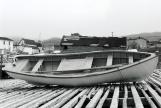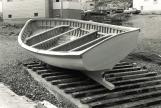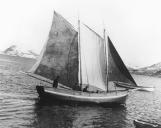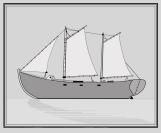1
15 ' 10" punt on the slipway. Built by Marcus French.August 1979
Winterton, Newfoundland, Canada
 Credits:
Credits:Photo by David A. Taylor
2
When not in use boats were either tied to the stage head or pulled up onto the slipway (ramp for hauling boats out of the water)There were many different kinds of boats that all had different purposes and therefore different structures. The earliest boats constructed were what are now called punts or rodneys. These were 14 to 18 foot long, sleek, narrow, and shallow boats, designed to be powered by oars. Sails would be used when conditions were favorable. The punt hull was shaped to be seaworthy and easily rowed with long oars at the bow and mid-ship and one longer sculling oar at the counter. They were used to fish for cod near shore.
There is some uncertainty over how this design came to the Trinity Bay area in the first place, but the early settlers likely brought it with them from places such as the southwest coast of England. European ships brought small boats varying in size from 14 to 50 feet to use in the Newfoundland fishery. It is likely that these boats influenced the design of punts, and other larger boats built in Winterton. The smaller of these European vessels were used to go ashore, to ferry fishermen or sailors from vessel to vessel, to help navigate the larger vessel in inshore waters, and to fish in shallower waters. In these very early times they were known by many names depending on the country of origin, the boat size and its use. Names such as pinnace (spelled pinnesse in Guy's letter), gig, jollyboat, skerry, barge, longboat, wherry, shallop, skiff, launch, yawl, and cutter have all been recorded. Many of these names remain in use today throughout the world but, with the exception of skiff, are not common in Winterton or the general Trinity Bay area.
3
Model of a bay punt2003
Winterton Boat Building and Community Museum, Newfoundland and Labrador, Canada

4
Some punts were built of slighter materials and used only for winter bird and seal hunting. These bay punts were usually longer, narrower and shallower than the fishing punt. These features allowed the boats to be pulled up onto the ice and improved the ease of handling.5
Built by Wilson, Hubert, and Charlie Reid, this completed trap skiff awaits an engine.August 1979
Winterton, Newfoundland, Canada
 Credits:
Credits:photo by David A Taylor in Petty Harbour after purchase by fishermen from that community
6
Another type of boat built in Winterton was the trap skiff. This boat was built for the changing fishing technology in the early 1990s when cod traps became the preferred method of catching codfish from May to early August.The trap skiff was larger and stronger than the punt and had greater stability which was needed to haul in the large cod traps. After around 1910 these boats were fitted with engines and from then on were also referred to as motorboats. At 20 to 30 feet, they were designed to use early gasoline, one-cylinder engines. They were used for fishing cod traps near-shore and baited trawls (long-lines) further offshore.
7
Schooners, Baccalieu skiffs and Baccalieu bullies in the Winterton harbour.1920
Winterton, Newfoundland

8
In the summer many Winterton fishermen fished the waters around Baccalieu Island, located 20 miles or so northeast of Winterton. The boats used were Baccalieu skiffs and Baccalieu bullies. Generally skiffs were open boats whereas bullies were partially or completely decked. Some of the larger of these were like small schooners but the over-all hull design was very much the same as the larger trap skiffs.Winterton was not known for the building of schooners though a small number were built there. Small schooners were used in Winterton to transport cured fish, fishing supplies, food staples and goods around the bay and to and from St John's. A small number of schooners over the years also fished at Labrador.
Sometimes when schooners and bullies were not in use their sails would be raised in the harbour to dry. Saturday would have been the only day when this would take place as the fishermen would spend the week days at Baccalieu Island and would come home on Friday night, unloading their catch the next day. Sunday was a day of rest. The fishermen would leave again for the fishing grounds after midnight on Sunday.
9
Boat resembling a Baccalieu skiff1920
Newfoundland
 Credits:
Credits:photo courtesy of the Provincial Archives of Newfoundland and Labrador
10
There are few known pictures of the Baccalieu skiff, which was not built after the 1920s. Descriptions suggest it resembled the boat shown in this picture.11
Diagram of a bully, based on a drawing from memory, by Alfred Green.2002
Winterton Boat Building and Community Museum, Newfoundland and Labrador, Canada

